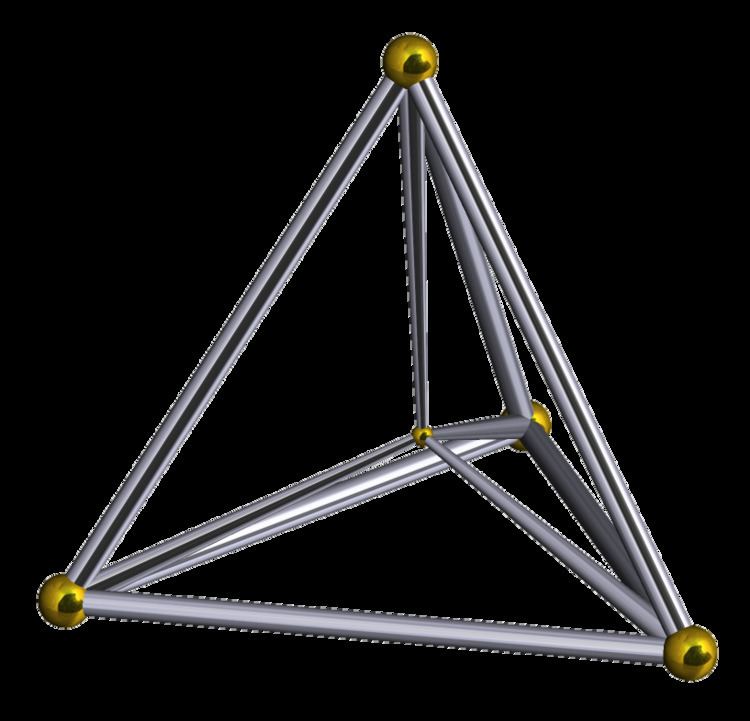 | ||
In geometry, a truncated 5-cell is a uniform 4-polytope (4-dimensional uniform polytope) formed as the truncation of the regular 5-cell.
Contents
- Truncated 5 cell
- Construction
- Structure
- Projections
- Alternate names
- Coordinates
- Bitruncated 5 cell
- Symmetry
- Alternative names
- Related regular skew polyhedron
- Related polytopes
- References
There are two degrees of trunctions, including a bitruncation.
Truncated 5-cell
The truncated 5-cell, truncated pentachoron or truncated 4-simplex is bounded by 10 cells: 5 tetrahedra, and 5 truncated tetrahedra. Each vertex is surrounded by 3 truncated tetrahedra and one tetrahedron; the vertex figure is an elongated tetrahedron.
Construction
The truncated 5-cell may be constructed from the 5-cell by truncating its vertices at 1/3 the edge length. This truncates the 5 tetrahedral cells into truncated tetrahedra, and introduces 5 new tetrahedral cells positioned on the original vertices.
Structure
The truncated tetrahedra are joined to each other at their hexagonal faces, and to the tetrahedra at their triangular faces.
Projections
The tetrahedron-first parallel projection of the truncated 5-cell into 3-dimensional space has the following structure:
This layout of cells in projection is analogous to the layout of faces in the face-first projection of the truncated tetrahedron into 2-dimensional space. The truncated 5-cell is the 4-dimensional analogue of the truncated tetrahedron.
Alternate names
Coordinates
The Cartesian coordinates for the vertices of an origin-centered truncated 5-cell having edge length 2 are:
More simply, the vertices of the truncated 5-cell can be constructed on a hyperplane in 5-space as permutations of (0,0,0,1,2) or of (0,1,2,2,2). These coordinates come from positive orthant facets of the truncated pentacross and bitruncated penteract respectively.
Bitruncated 5-cell
The bitruncated 5-cell (also called a bitruncated pentachoron, decachoron and 10-cell) is a 4-dimensional polytope, or 4-polytope, composed of 10 cells in the shape of truncated tetrahedra.
E. L. Elte identified it in 1912 as a semiregular polytope.
Each hexagonal face of the truncated tetrahedra is joined in complementary orientation to the neighboring truncated tetrahedron. Each edge is shared by two hexagons and one triangle. Each vertex is surrounded by 4 truncated tetrahedral cells in a tetragonal disphenoid vertex figure.
The bitruncated 5-cell is the intersection of two pentachora in dual configuration. As such, it is also the intersection of a penteract with the hyperplane that bisects the penteract's long diagonal orthogonally. In this sense it is a 4-dimensional analog of the regular octahedron (intersection of regular tetrahedra in dual configuration / tesseract bisection on long diagonal) and the regular hexagon (equilateral triangles / cube). The 5-dimensional analog is the birectified 5-simplex, and the
The bitruncated 5-cell is one of the two non-regular uniform 4-polytopes which are cell-transitive. The other is the bitruncated 24-cell, which is composed of 48 truncated cubes.
Symmetry
This 4-polytope has a higher extended pentachoric symmetry (2×A4, [[3,3,3]]), doubled to order 240, because the element corresponding to any element of the underlying 5-cell can be exchanged with one of those corresponding to an element of its dual.
Alternative names
Coordinates
The Cartesian coordinates of an origin-centered bitruncated 5-cell having edge length 2 are:
More simply, the vertices of the bitruncated 5-cell can be constructed on a hyperplane in 5-space as permutations of (0,0,1,2,2). These represent positive orthant facets of the bitruncated pentacross. Another 5-space construction, centered on the origin are all 20 permutations of (-1,-1,0,1,1).
Related regular skew polyhedron
The regular skew polyhedron, {6,4|3}, exists in 4-space with 4 hexagonal around each vertex, in a zig-zagging nonplanar vertex figure. These hexagonal faces can be seen on the bitruncated 5-cell, using all 60 edges and 20 vertices. The 20 triangular faces of the bitruncated 5-cell can be seen as removed. The dual regular skew polyhedron, {4,6|3}, is similarly related to the square faces of the runcinated 5-cell.
Related polytopes
These polytope are from a set of 9 uniform 4-polytope constructed from the [3,3,3] Coxeter group.
